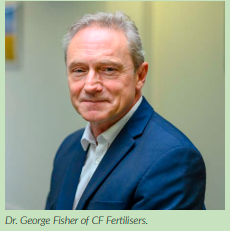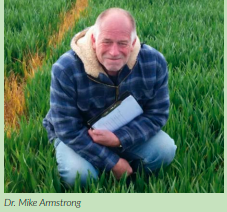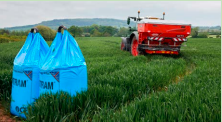The carbon footprint of all agricultural practices is under the spotlight as never before, and with Nitrogen fertiliser one of the mainstays of production, it is not surprising much debate continues around the use of manufactured N.
Navigating through the often conflicting demands of population growth, food production needs and environmental requirements is far from easy, says Dr. George Fisher of CF Fertilisers.

“It’s a balance between using Nitrogen as efficiently as possible onfarm to produce the food we need, whilst making sure this is done in such a way to limit harm to the environment with products that are manufactured as cleanly as possible. “Over the next 50 years global population will increase by 30% to 9 Billion people, food production will need to double to feed an increasingly hungry world and the demands placed on farmers and growers will be unprecedented. “Yet, all this is happening against a backdrop of growing awareness of the need for us all to limit our impact on the environment, cut back significantly on greenhouse gas emissions and manage the world’s finite resources more carefully. “And with climate change reducing the area of land in temperate areas where current food crops can grow, the need to achieve the highest food production efficiency from every hectare possible will be greater than ever.
Fertilisers can double crop yields
It’s an unavoidable fact that over the last 60 years, Nitrogen application has driven the food production revolution, Dr Fisher says that, without fertilisers, the world would only be able to feed about half of its people. Modern fertilisers can double crop yields.
Research data from trials
In practice, fertiliser is a crucial element to achieving profitable crop yields. CF trials consistently show optimum N applications producing over 5.0t/ ha more wheat compared to zero N application plots. “For example, in milling wheat trials carried out by arable research contractors Armstrong Ltd, applying zero N to trial plots produced 4.2 t/ha whereas applying the optimum N rate of 254kg N/ha produced 10.4t/ha. “Whilst optimum N rates are key, the type of fertiliser used can also have a profound effect on how it is utilised by plants. “It’s important to ensure that as much as possible of every kg of Nitrogen fertiliser applied ends up in plants to produce food and is not lost from the system in terms of leaching or loss to the air.”
Nitrogen fertiliser use efficiency (NfUE) critical metric
The Clean Air Strategy 2019 has focused peoples’ minds on Nitrogen fertiliser use efficiency (NfUE) with a suggested move away from urea to Ammonium Nitrate (AN) or inhibited urea products to reduce Ammonia emissions, he explains. “NfUE gives growers a clearer picture of the impact their fertiliser choices are having on their production efficiency and can highlight where potential environmental concerns might result. “In simple terms, it allows us to review the amount of Nitrogen applied to crops and calculate how much is actually recovered by the crop. “Efficiency values for crops typically range between 50% to 80% but it is clear that better quality, AN based solid fertilisers are at the top end of this scale whereas urea-based products, including liquids and blends, tend to be at the lower end.
” In independent trials, Nitram (34.5% N) outperformed straight urea in terms of NfUE across all trials conducted in two very different production years and at all yield levels, Dr. Fisher points out. “Looking at the data from six trials shows an average NfUE for the AN of 74% compared to 66% for urea. “This difference of 8% NfUE is the equivalent of an additional 16% total loss of Nitrogen from urea and in crops. With an application rate of 200kg/ha N this would be equivalent to a loss of 32kg/ha N.

“In other words, using Nitram resulted in crops recovering an extra 16% or 32kg/ha N than they would have done with the same application rate of urea.”
Even in 2018 when poor weather meant all treatments on all trials had a relatively poor recovery of Nitrogen, Nitram still outperformed urea, he says. “NfUE analysis dispels the continued sentiment that whilst urea volatilises N to the air, AN leaches to groundwater so the overall environmental impact from both products is similar. “It’s just not the case. The N losses through volatilisation from urea are far greater than any perceived losses with AN through loss via the soil. Urea has the potential to leach nitrate-N via soil processes in addition to losing N as ammonia. “Even with inhibited urea-based products designed to reduce loss of Ammonia to the air, volatilisation is still an issue.”
Trials underline AN benefits
High quality Ammonium Nitrate (Nitram – 34.5%N) achieved an average Nitrogen Fertiliser Use Efficiency (NfUE) of 70% compared to 60% for UAN and just 63% for UAN treated with the latest polymer-based inhibitor products, in ADAS trials carried out in 2019.

In practical terms, the better NfUE from Nitram AN produced an extra 0.4t/ha of milling wheat over crops using a urea fertiliser as their only source of Nitrogen in trials carried out by Armstrong Ltd. At all fertiliser rates, Ammonium Nitrate (AN) outperformed, explains Dr. Mike Armstrong. “There was a significant yield advantage in favour of AN across all plots in the trial. Even where urea was used as an early application and then followed by AN, there was a 0.25t/ ha drop in yield compared with crops given all their Nitrogen as AN.
“We wanted to look at all possible scenarios of urea use versus AN so as well as a direct comparison of the two, we also wanted to test the idea that urea can be a safe, lower-cost early application. “An application of 50kg N/ha of urea was applied in these instances with remainder of the fertiliser application being made up of 34.5% Nitram AN.” A range of application rates up to 360kg N/ha were used with the optimum rate found to be 254kg N/ha. “At this rate, the AN crops were producing 10.3t/ha whilst the urea ones were at 9.9 t/ha.”
Major steps in manufacturing efficiency
While focusing on choosing the right product to maximise NfUE and reduce loss on N to the atmosphere another key component is the carbon footprint of manufacture, CF Fertiliser’s’ director of public affairs Debbie Baker points out. “For our part, we’ve made major steps in reducing the greenhouse gas emissions associated with our fertiliser production, worked hard to produce accurate carbon footprints for all our products and made significant steps forward with recycling throughout all our processes.

“CF Fertilisers has over 50 years experience in production and supply of the highest integrity fertiliser products. We manufacture Ammonium Nitrate (Nitrogen) Fertilisers at our sites at Ince in Cheshire and Billingham in Teesside. At Ince, we also combine Nitrogen with the other plant nutrients Phosphorus, Potassium and Sulphur to create true granular compounds that meet the wide variety of soil type and crop requirements found in the UK.”
Sustainable Nitrogen Production
Of the four million tonnes of Nitrogenbased fertiliser products used in British Agriculture every year, with CF manufacturing and supplying up to 35% of this. “You can’t get away from the fact that fertiliser production is an energy intensive process,” Debbie Baker explains. “But over recent years CF Fertilisers has invested heavily in ensuring that our manufacturing is as efficient as possible and has the least impact on the environment. It’s an area we are committed to investing in for the longterm too. One such investment has been to install state-of-the-art nitrous oxide (N2O) abatement technology on the nitric acid plants at Billingham. “N2O is an unavoidable byproduct of nitric acid manufacture and is a significant greenhouse gas.
The nitric acid is a key base for Ammonium Nitrate production. Over the last few years, we’ve invested £9M in our manufacturing facilities to reduce our production of N2O emissions by 3000 tonnes every year. “As a greenhouse gas, N2O is 300 times more powerful than CO2 in terms of it’s effect on the environment, so that’s equal to 900,000 tonnes of CO2 . “This is equivalent to the whole of the 30% CO2 reduction required by UK agriculture by 2022, so it’s a sizeable amount and indicative of the effort and resources we have put in to make sure our own production is as sustainable and environmentally acceptable as possible. “All told we’ve reduced the carbon footprint of Nitram production by 40% since 2010.
Working with the Carbon Trust
To make the major improvements in manufacturing and emissions reduction as practically useful as possible to customers, CF has produced businessto-business (or cradle to farmgate) fully audited and certified carbon footprints for its entire range of fertilisers as well as the ammonia and nitric acid used in the manufacture of its Ammonium Nitrate. To ensure these carry maximum credibility and are readily recognised by everybody as 100% independently verifiable, the company took the decision to work with the Carbon Trust to achieve this, Debbie explains.

“Not only does this mean they have undergone rigorous independent scrutiny, they have also been calculated using the standards set out in the robust and internationally recognised PAS 2050 protocol. “The resulting footprint represents the true carbon emissions for fertiliser production from the raw materials right up to delivery to the farm gate.” CF Fertilisers product carbon footprints were first certified by the Carbon Trust in April 2013 and are reassessed every two years. The footprints for process chemicals are expressed as kg CO2 e per kg of product, whereas fertiliser products are given as kg CO2e per kg Nitrogen (N). “Fertiliser usage in on-farm Nutrient Management Plans is considered on the basis of N requirement, so this approach allows the simplest comparison between our products for a given crop requirement.
“The process doesn’t end there, though. In using the carbon reduction label, CF Fertilisers has promised to reduce the footprint for process chemicals and Nitram, demonstrating an ongoing commitment to carbon reduction.”
On farm benefits of carbon-focused thinking
The investment in manufacturing, research and knowledge sharing is starting to have real benefits for farmers moving forward, says Dr. Fisher. “Emerging legislation, such as that coming out of the Clean Air Strategy, will make using urea increasingly difficult in the future and with its use being very dependent on the weather, it also puts a much greater element of risk into your business. “Every producer, whether livestock or arable, should now carry out and follow a Nutrient Management Plan and Carbon audits will become increasingly important in the future.
“Some milk buyers are already asking their suppliers to provide this information and one of the biggest elements of this is your fertiliser use. “It’s something we have been aware of for some years now and whilst the international standard figure is 6.6kg of Carbon for every 1.0kg of N you use, with CF Ammonium Nitrate (Nitram) it is almost half this at 3.4kg for every 1.0kg of N used. “This is a result of the investment we have made in de-carbonising the manufacturing process.”
Little and often applications improve fertiliser use efficiency
Little and often applications of Nitrogen can boost milling wheat yields by nearly 0.4t/ha without causing dilution of grain protein content, new research from ADAS is suggesting.
While yield from 260kg N/ha applied as four applications at one site produced a yield of 11.73t/ha, this rose to 12.11t/ha with the same grain protein content when the same amount of fertiliser was applied as seven applications, explains ADAS crop physiologist Dr. Kate Storer.
The trials were carried out in Terrington, Norfolk, and Wharram-leStreet, Yorkshire. The Norfolk site was on a silty clay loam with the variety Skyfall after oilseed rape whilst the Yorkshire site was on a silty clay loam over chalk, using the variety Elicit after beans.

N-Min soil testing was carried out to ascertain soil N resources with a total Soil Nitrogen Supply (SNS) of 92kg N/ha recorded at Terrington. N-Calc was then used to produce an estimate of 260kg N/ha applied N would be needed to achieve yield and quality targets. Fertiliser was applied as high quality Ammonium Nitrate (Nitram 34.5%) with the standard plots receiving an initial application of 50kg N/ha on 22 February followed by further applications of 80kg N/ha at GS 31, 80kg N/ha at GS 32 and a final one of 50kg N/ha at GS 37/39.
The L&O plots received an initial application of 25kg N/ha on 22 February followed by a further application of 25kg N/ha in early March and then four applications of 40kg N/ ha at GS 30, 31, 32, 33 and a final one of 50kg N/ha at GS 37/39. The second trial at Wharram-le-Street in Yorkshire used a similar approach with a lower total N application of 230 kg/ha over six splits, she explains. “The L&O timings were designed so that they fed the crop as it grew and avoided excess N in the soil early in the season. “At Wharram-le-Street the dry conditions after some of the later L&O applications may have delayed N uptake in those plots, with lower Normalised Difference Vegetation Index (NDVI) values seen in the L&O treatments, but there was no negative effect on yield.
” That said, at harvest, analysis showed there was a trend for higher NfUE in the L&O plots at both sites. It is likely most of the additional N uptake in the L&O crops took place as they were actively growing in spring and early summer, Kate Storer believes. “There was an increase in N straw concentration in the L&O plots suggesting the greater N uptake efficiency resulted from more N being taken up by plants during stem extension and ear formation.
“As well as improved production opportunities, it is possible the greater N uptake from the L&O approach may also reduce the risk of nitrate leaching during the following winter, so there are potential environmental benefits too.”